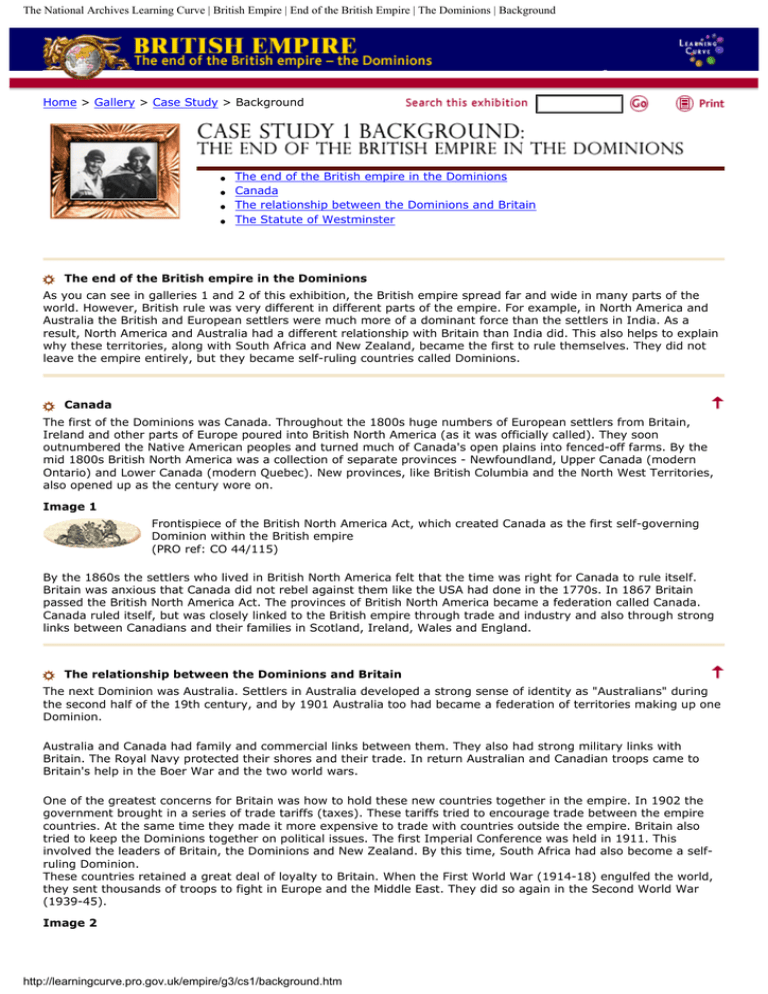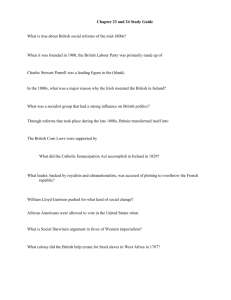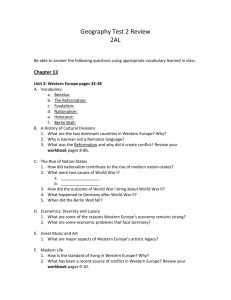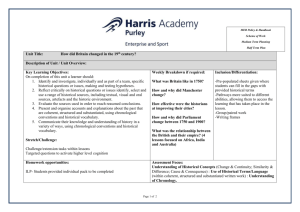Document 11403563
advertisement

The National Archives Learning Curve | British Empire | End of the British Empire | The Dominions | Background Home > Gallery > Case Study > Background ● ● ● ● The end of the British empire in the Dominions Canada The relationship between the Dominions and Britain The Statute of Westminster The end of the British empire in the Dominions As you can see in galleries 1 and 2 of this exhibition, the British empire spread far and wide in many parts of the world. However, British rule was very different in different parts of the empire. For example, in North America and Australia the British and European settlers were much more of a dominant force than the settlers in India. As a result, North America and Australia had a different relationship with Britain than India did. This also helps to explain why these territories, along with South Africa and New Zealand, became the first to rule themselves. They did not leave the empire entirely, but they became self-ruling countries called Dominions. Canada The first of the Dominions was Canada. Throughout the 1800s huge numbers of European settlers from Britain, Ireland and other parts of Europe poured into British North America (as it was officially called). They soon outnumbered the Native American peoples and turned much of Canada's open plains into fenced-off farms. By the mid 1800s British North America was a collection of separate provinces - Newfoundland, Upper Canada (modern Ontario) and Lower Canada (modern Quebec). New provinces, like British Columbia and the North West Territories, also opened up as the century wore on. Image 1 Frontispiece of the British North America Act, which created Canada as the first self-governing Dominion within the British empire (PRO ref: CO 44/115) By the 1860s the settlers who lived in British North America felt that the time was right for Canada to rule itself. Britain was anxious that Canada did not rebel against them like the USA had done in the 1770s. In 1867 Britain passed the British North America Act. The provinces of British North America became a federation called Canada. Canada ruled itself, but was closely linked to the British empire through trade and industry and also through strong links between Canadians and their families in Scotland, Ireland, Wales and England. The relationship between the Dominions and Britain The next Dominion was Australia. Settlers in Australia developed a strong sense of identity as "Australians" during the second half of the 19th century, and by 1901 Australia too had became a federation of territories making up one Dominion. Australia and Canada had family and commercial links between them. They also had strong military links with Britain. The Royal Navy protected their shores and their trade. In return Australian and Canadian troops came to Britain's help in the Boer War and the two world wars. One of the greatest concerns for Britain was how to hold these new countries together in the empire. In 1902 the government brought in a series of trade tariffs (taxes). These tariffs tried to encourage trade between the empire countries. At the same time they made it more expensive to trade with countries outside the empire. Britain also tried to keep the Dominions together on political issues. The first Imperial Conference was held in 1911. This involved the leaders of Britain, the Dominions and New Zealand. By this time, South Africa had also become a selfruling Dominion. These countries retained a great deal of loyalty to Britain. When the First World War (1914-18) engulfed the world, they sent thousands of troops to fight in Europe and the Middle East. They did so again in the Second World War (1939-45). Image 2 http://learningcurve.pro.gov.uk/empire/g3/cs1/background.htm The National Archives Learning Curve | British Empire | End of the British Empire | The Dominions | Background Photo of ANZAC troops (Australian and New Zealand Army Corps) in the Western Desert during the Second World War, 1942 (PRO ref: INF 1/244) The Statute of Westminster In 1931 the Statute of Westminster officially gave the Dominions the full power to rule themselves, although in practice they already did this. The Dominions were completely independent states. By this stage the Irish Free State had also become a Dominion, although Northern Ireland remained part of the United Kingdom. There was controversy in Britain over the Statute. Winston Churchill led a number of MPs who bitterly opposed it. Churchill felt that Britain owed its greatness to the empire and that the Statute weakened Britain dangerously. However, he was completely out of step with the views of most British people and most British MPs. The fact was that most of the Dominion countries already ruled themselves. The Statute of Westminster was mainly designed to sort out red tape. There were sometimes legal complications because the constitutions of the Dominions said that on some issues the Dominions had to get permission from the British Parliament to pass certain laws. The Statute of Westminster simply allowed the Dominions to pass any laws they wished to pass without having to consult the British Parliament. There was also some debate about the issue in New Zealand, which did not accept the Statute until 1944, but in general there was a strong feeling that the time was right. As far as the Dominions were concerned, the British empire ended by a peaceful process of legal independence given by Britain. The major exception to this was in Ireland (see case study 4 in this gallery). Feedback | Credits | Sitemap | Help http://learningcurve.pro.gov.uk/empire/g3/cs1/background.htm Glossary | World Maps Background source 1 Transcript | Print | Close Frontispiece of the British North America Act, which created Canada as the first selfgoverning Dominion within the British empire (PRO ref: CO 44/115) Top of page | Print | Close http://learningcurve.pro.gov.uk/empire/g3/cs1/g3cs1s1_bg.htm Background source 2 Print | Close Photo of ANZAC troops (Australian and New Zealand Army Corps) in the Western Desert during the Second World War, 1942 (PRO ref: INF 1/244) Top of page | Print | Close http://learningcurve.pro.gov.uk/empire/g3/cs1/g3cs1s2_bg.htm





